Diploma 2014: "Grenselandet [Land of boundaries]" by Tone Dybing
a structure of imprisonment in Arendal
Grenselandet [Land of boundaries]
A structure of imprisonment in Arendal, Aust-Agder
The prison has always had the function as a penal institution, but it has undergone significant functional changes through time based on society’s ideal of what imprisonment should be. The prison as a typology is very much driven by cultural values and social theories, where ideology and architecture is closely linked. The architecture of the prison reveals what punishment the society believes in.
Former prisons were built on principles of full isolation and no contact with the outside world. Today the tendencies show a stronger focus on community amongst the inmates and an idea of progression towards a life on the outside. Deprivation of liberty is what is looked upon as the punishment in the Norwegian context, though the main purpose of the prison is to prevent crime rather than to punish. It is rehabilitation which is the focus. Norway operates with two main types of prisons; prisons with high and low level of security (formerly designated as closed and open prisons). It has repeatedly been discussed whether there should be any changes in the current categorization of prisons by adding a more nuanced structure of imprisonment.
The general rule is that all atonement starts in a prison with high level of security, and due to the great distances between the security levels of high and low security today, prisoners will carry out most of their penalty there. At the same time are the security requirements getting so strict that they are no longer representative for the average population of inmates. The project takes part in the debate about making a more gradual transition between high and low security. The aim is to provide a progression system within the prison structure by developing departments with different security levels to safeguard the various groups of prisoners.
The context of the project is the counties of Agder where the prisons experience a lack of capacity, as well as poor and old facilities. This leads to prisoners being sent away from home, family and important support network to carry out their sentence. The result is a greater feeling of isolation during the time of imprisonment and difficulties in the process of rehabilitation and the reintegration in the time after the release. The prisoners should be in a prison close to home to counteract social isolation and facilitate contact with family and community.
The project suggests a master plan, and deals with an overall programmatic, relational and logistical plan that is based on a process of research and discussions around existing prisons and how the typology has changed over time. The master plan draws experiences from organizational and architectural elements of the research, resulting in a hybrid combining different strategies for building prisons. The aim has been to discuss how we might prevent some of the damage effects that is experienced from incarceration through architectural measures, and how to achieve more humane and rehabilitative environments inside the prison.
The diploma works with manipulating elements familiar in the prison architecture to achieve more transparent borders, while exploring alternative ways of reinsuring security. It focuses on implementing new qualities such as visual connection between inside and outside to give a stronger experience of place, as well as developing urban qualities resembling those of a city.
The aim has been to suggest basic principles and ideas that can be relevant in other contexts when developing prisons, but the project is at the same time developed in a close relation to the specific qualities of the site.
The discourse on prisons is complex, and filled with nuances. The aim is not to present a complete answer on all levels, but to shed some light on ways in which the prison can continue to evolve into becoming even better as a rehabilitative institution.
All photos: Tone Dybing
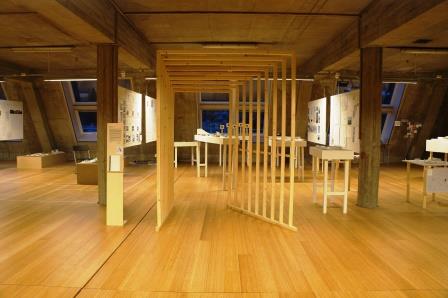
An overview image of the exhibition.

Key model - The Portal
The model is a representation of the program of the diploma project.It is an element defining two sides that are different.
It represents the transition from a space that is more open, to a space that is more enclosed, and this element defines the movement between these two spaces, as a portal.The name of the project is Grenselandet, or Land of Boundaries, and is dealing with diffusing borders. The project is a structure of imprisonment in Arendal.
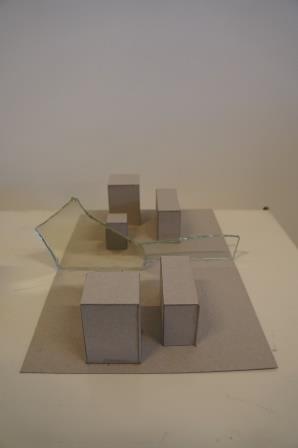
Concept model - First thoughts.
Similarity.
How similar is the outside and the inside of the prison?
How similar should it be? How similar can it be?
Can one achieve a closer connection to the outside society?
Can one mirror the society better within the prison?
Can similarity better maintain identity?
The border between these to states, as sharp, but still transparant.
Can one increase the transparency of this border?
Differentness.
How different should the outside and the inside be in relation to each other.
Why should there be a distant rural location?
What can one achieve with a close urban connection?
What institution-like traits can’t one escape when dealing with the institution?
How can one challenge the total institution based on thoughts of the heterotopia?
The prison and the imprisonment.
The building and the function.
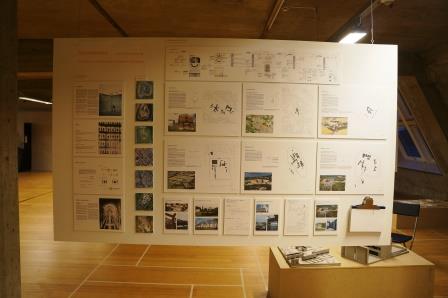
The research on the prison-typology.
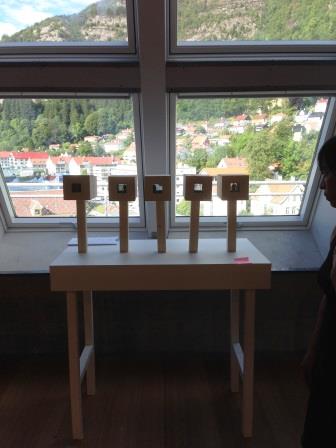
Tittskåpene.
Five boxes telling five stories about how important the visual connection to something on the outside is
to the person that is experiencing imprisonment. Stories from former prisoners and relatives telling
about the experience of being in prison.
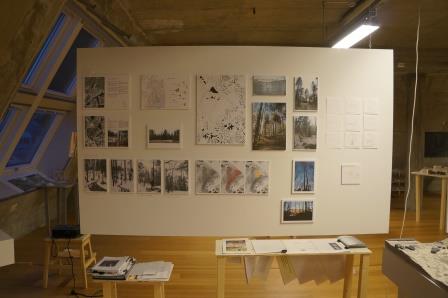
The investigations of the site.
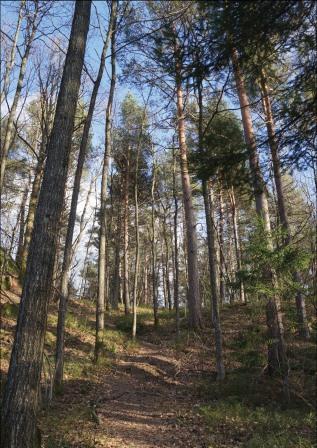
Picture from the site, a pine forest in a steep landscape
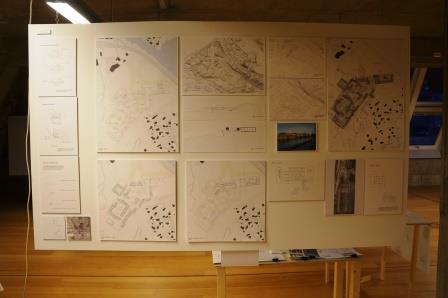
The presented material of the final project
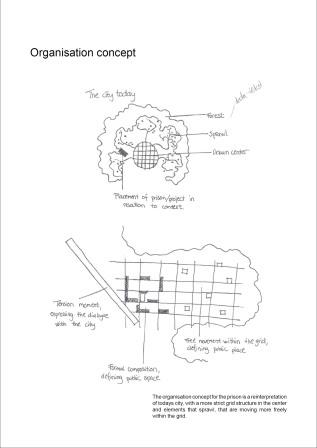
Organisation concept
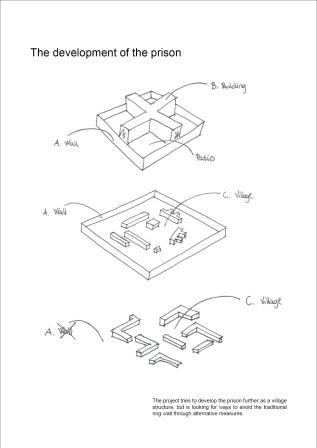
The development of the prison
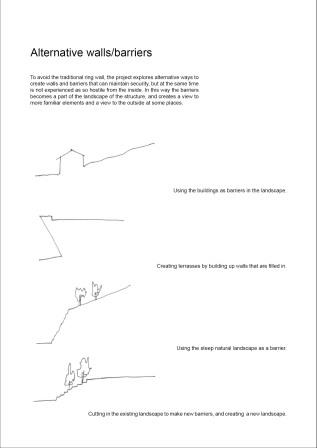
Alternative walls/barriers
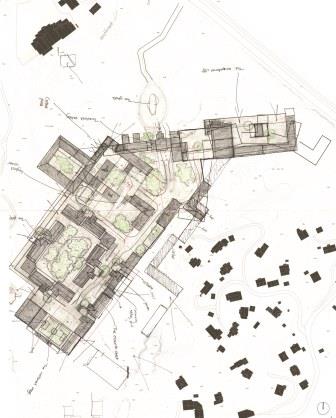
The sketch for the situation plan of the prison
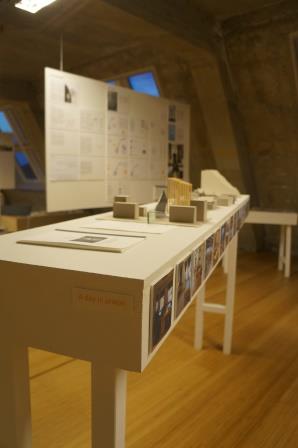
Model 1-1000, the pattern of the new prison structure, creating a small village.

“The first time I saw a tree again I just sat and stared. For a long time.” - Rune
A former inmate’s story about the experience of imprisonment, told at “Fagkveld om isolasjon” at the Faculty of Law, University in Bergen, in May 2014.
Damage effects of incarceration
Both international and Norwegian research documents various unintended effects and social implications caused by imprisonment. These include one of the reasons for the international recommendations that prison should only be used when necessary. The inmates often come from poor living conditions. If imprisonment reinforces these then the forecast to survive in society after release is even worse.
Damage effects of imprisonment may be:
(Hammerlin & Kristoffersen, 1998)
- Losing Touch with Loved Ones.
- Losing contact with other positive forces in society.
- Risk of losing job.
- Interruption of education or training.
- The risk of suicidal thoughts.
- Risk of mental disorders.
- Loneliness.
- Get in touch with people with criminal attitudes.
- Risking recruitment to criminal groups.
- Connect with drugs.
- The risk of being exposed to violence.
- Be socially stigmatized.
- To start or reinforce deviation career.
- Risking a high threshold for re-entry into society.
- Risking discrimination by the sentence.
- Can develop revenge against society.
The list of losses is long:
- Institutionalization
- Marginalisation
- Isolation
- Inaktivisering, passivation
- Alienation
- Disorientation
- Competence Destruction, disqualification
- Impotence
- Loss of property
- Loss of opportunity to use certain goods or services
- Loss of development
- Despair, anxiety disorders, grief, frustration
- Loss of love, sexuality, care
- Loss of security
- Forced unwanted contacts
- Loss of self-determination
- Poverty
- Culture Poverty
- Personal integrity is threatened or weakened
How can one create more humane and rehabilitative environments within the prison?
